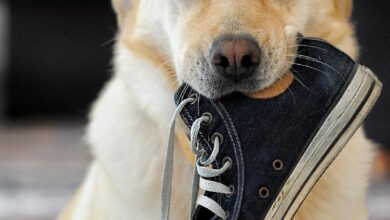Behaviour
Advanced Labrador Training: Recall, Barking, and Separation Anxiety

BY STAFF WRITER
Labradors are eager to please, but training them in recall, barking control, and separation anxiety requires patience and consistency. Below are detailed, step-by-step training plans to help your Lab master these behaviours.
Teaching Reliable Recall (Coming When Called)
Why Some Labs Ignore “Come”?
- They’ve learned that “Come” means the fun is over (e.g., leaving the dog park).
- They don’t associate “Come” with rewards.
- There are too many distractions (squirrels, smells, other dogs).
Goal: Teach your Lab that coming to you is the best thing ever!
Step-by-Step Recall Training Plan
Choose a Special Recall Word
- Instead of the usual “Come,” try “Here!” or “To me!” in a happy voice.
- Make sure it’s only used for recall, never punishment.
Start Indoors with No Distractions
- Sit on the floor, say “Here!” and show a treat.
- When your Lab comes, praise and reward immediately.
- Repeat in different rooms until they respond quickly.
Add Distance and Mild Distractions
- Move 5-10 feet away, call your Lab, and reward when they come.
- If they hesitate, clap, squat down, or run a few steps away to encourage movement.
- Never chase your dog – it becomes a game!
Use a Long Leash for Outdoor Practice
- Attach a 15-30 ft leash and practice in a yard or quiet park.
- Call them excitedly—if they ignore you, gently reel them in and reward.
- Increase difficulty by practicing around mild distractions (other people, toys).
Make Recall Rewarding
- Use high-value treats (chicken, cheese, hot dogs).
- Sometimes give extra rewards (playtime, a fun chase game) so they always expect something good.
Common Mistakes:
- Calling them only when playtime ends – mix it up!
- Repeating “Come” too much – say it once, then encourage with movement.
- Punishing them after they come – never scold a slow response.
Stopping Excessive Barking
Why Do Labradors Bark Too Much?
- Attention-seeking: They bark to get food, play, or petting.
- Boredom: Labs need mental and physical exercise.
- Alerting: They hear a noise and react.
- Anxiety: Separation distress can lead to barking.
Goal: Teach your Lab to bark less and stay calm.
Step-by-Step Barking Control Plan
Identify the Trigger & Remove the Reward
If barking at people outside: Close the curtains or move them to another room.
If barking for attention: Ignore them completely (no eye contact, talking, or touching). Reward silence.
Teach the “Quiet” Command
- Wait for a barking pause, then say “Quiet” in a calm voice.
- Immediately give a treat & praise for silence.
- Repeat until they associate “Quiet” = Reward.
Desensitize to Noises
- Play doorbell sounds or outside noises at low volume.
- Reward calm behaviour.
- Slowly increase volume over time to build tolerance.
- Give Them Something Else to Do
- If they bark at the doorbell, teach them to go to a specific place (like a mat or crate).
- If barking when alone, leave a food puzzle or interactive toy.
Common Mistakes:
- Yelling “No!” – this can sound like barking and make it worse.
- Accidentally rewarding barking (giving attention too soon).
- Not giving enough exercise – a tired Lab barks less!
Stopping Separation Anxiety (Preventing Destructive Behaviour & Whining)
Why Some Labradors Struggle with Being Alone?
- They are social dogs and form strong bonds.
- They haven’t learned to be comfortable alone.
- Owners accidentally reinforce clingy behaviour (giving too much attention before leaving).
Goal: Teach your Lab that being alone is safe and normal.
Step-by-Step Separation Anxiety Training Plan
Create a Calm Pre-Departure Routine
- Ignore your Lab 10-15 minutes before leaving (no dramatic goodbyes).
- Offer a stuffed Kong or puzzle toy right before you go to keep them busy.
Practice Short Departures (Desensitization)
- Start by leaving for 1-2 minutes and returning calmly.
- Gradually increase time away (5, 10, 15 minutes).
- If they stay calm, reward them with gentle praise.
- Teach “Stay” in a Separate Room
- Have your Lab lie down and stay while you step out for a few seconds.
- Return before they get anxious – reward calmness.
- Increase time gradually to simulate alone time.
Use Background Noise
- Leave soft music or white noise to create a relaxing environment.
- Try dog-friendly TV shows or audio recordings of your voice.
Reward Independence
- Give treats when they settle down alone, not when they’re following you everywhere.
- Use a designated resting spot (crate, dog bed) with rewards for staying there.
- Common Mistakes:
- Making a big deal when leaving or returning (stay calm).
- Letting them follow you everywhere – teach independence.
- Leaving them alone too long too soon – build up gradually.
Final Training Tips for Success
- Be Consistent: Use the same commands & techniques daily.
- Keep Sessions Short: 5-10 minutes is best for focus.
- Reward Calm Behaviour: Don’t wait for bad behaviour to give attention.
- Exercise First: A tired Labrador is easier to train and less anxious.
Follow Us






